A Practically Free IPT
If you would like to learn about joining me east of Jacksonville, FL for a week of great photography and instruction this July — for next to nothing, please shoot me an e-mail. Share and AirBnB and ride to, on, and from the beach with me. Airport pickup possible.
Your Call?
Which image do you like best? Why?
Important Notice
After an update on 4 May, WordPress stopped sending post notifications. We are aware of the issue and are working on rectifying it. You can always visit the blog by visiting or bookmarking www.BIRDSASART-Blog.com.
Supporting My Efforts Here
If you enjoy and learn from the blog, please consider using one of my affiliate links when purchasing new gear. It will never cost you a single penny. To support my effort here, please order from B&H by beginning your search here. Or, click here, to order from Bedfords and enter the discount code BIRDSASART at checkout to receive 3% cash back to your credit card and enjoy free Second-Day Air Fed-Ex shipping. It is always best to write for advice via e-mail.
In many cases, I can help you save some serious dollars. And/or prevent you from purchasing the wrong gear.
What’s Up?
Today is Sunday 2 June 2024. This blog post took about more than five hours to prepare — a labor of love. Have a great day.
|
|
|
This image was created by a visiting Clemens Van der Werf on the morning of 1 May 2024 down by the lake near my home at ILE. He used my Robus RC-5558 Vantage Series 3 Carbon Fiber Tripod/Levered-Clamp FlexShooter Pro-mounted Canon EF 180mm f/3.5L Macro USM lens with Canon Mount Adapter EF-EOS R and his Canon EOS R3 Mirrorless Camera. ISO 1000: 1/50 second at f/8 (stopped down 2 1/3 stops) in Manual Mode. AWB at 7:28:00pm in the shade of my body on a mostly clear afternoon. Manual focus with focus peaking. Click on the image to enjoy a larger version. Image #1: 1-day old at most Killdeer chicks in scrape nest
|
So Much For Being Mister Nice Guy
I had suspected for several weeks that there was a killdeer nest on the ornamental rock garden by the bathroom down by the pier at ILE. But I did not find it until the afternoon of 30 April of this year. After staring at the same spot for several minutes, I finally was able to make out one tiny, perfectly camouflaged chick and two eggs in a small scrape nest. The nest morning I photographed three chicks in the nest with my 600mm lens. You are not seeing it here for a reason; it is not very good.
Clemens, visiting his adopted state from The Netherlands, came by for dinner on May 1st asa we had made a reservation to photograph on a pontoon boat at Lek Blue Cypress the next morning. After we ate, we headed down to the lake to check things out. There were two tiny chicks in the nest and no eggs or eggshells. The first hatched chick must have gone for a walkabout. Shorebird chicks are precocial. Pretty darn soon, sometimes within hours of hatching, they fluff out their feathers and wander away from the nest, picking at bits of food as they go.
Anyhoo, I crabbed my Canon 180 Macro lens, the Metabones adapter, and an a-1 and went to work. Clemens kindly shaded the nest from the late after sun with his body. The two chicks laid there with their eyes close. Clemens mounted his Canon R3 to my favorite macro lens via the Canon Mount Adapter EF-EOS R. As luck would have it both chicks opened their eyes as one of them raised its head. Bingo for Clemens, bummer for me 🙂
Note that the chick on our right has the egg tooth on the tip of its bill. That helps them chip away at the eggshell so that it can escape and hatch. It has disappeared from the bill of the chick on our left so that one is likely older by a day (or two at most).
|
|
|
This image was created on 6 May 2024 down by the lake near my home at Indian Lake Estates, FL. Working from the driver’s seat of my SUV, I used the BLUBB-supported Sony FE 600mm f/4 GM OSS lens, the Sony FE 2.0x Teleconverter, and The One, the Sony Alpha 1 Mirrorless Digital Camera). The exposure was determined via Zebra technology with ISO on the thumb dial. ISO 1600. 1/320 sec. at f/9 (stopped down 1/3-stop) in Manual mode. When evaluated in RawDigger, the raw file exposure was determined to be perfect. AWB at 7:39:41am on variably cloudy morning. Tracking: Expand Spot/AF-C performed perfectly even at 1200mm. Be sure to click on the image to enjoy a high-res version. Image #2: Killdeer — 7-day old chick |
Seven Days Old
This chick is almost surely seven days old, eight at the very most. On the morning of 6 May, I was thrilled to find all three chicks in the far southwest corner of the ILE “beach.” I posted a shot of one of the three chicks from that morning: Image #2 in the blog post here.
I love the two tone background and the chicks cyan colored ankles. Yes, what you think are a bird’s knees actually correspond to a human’s ankles.
|
|
|
This image was created on 7 May 2024 down by the lake near my home at Indian Lake Estates, FL. Working from the driver’s seat of my SUV, I used the BLUBB-supported Sony FE 600mm f/4 GM OSS lens, the Sony FE 1.4x Teleconverter, and The One, the Sony Alpha 1 Mirrorless Digital Camera). The exposure was determined via Zebra technology with ISO on the thumb dial. ISO 1600. 1/320 sec. at f/.6 (wide open) in Manual mode. When evaluated in RawDigger, the raw file exposure was determined to be perfect. AWB at 7:14:14am on variably cloudy morning. Tracking: Expand Spot/AF-C performed perfectly even at 1200mm. Be sure to click on the image to enjoy a high-res version. Image #3: Killdeer — adult calling chicks on 7 May |
Good Parent
At the exact same spot the next morning, one of the adults was calling the chicks. All three responded and disappeared under momma or poppa in a few moments. Though in prefect position, I never got to press the shutter button.
|
|
|
This image was created on 25 May 2024 down by the lake near my home at Indian Lake Estates, FL. Working from the driver’s seat of my SUV, I used the BLUBB-supported Sony FE 600mm f/4 GM OSS lens, the Sony FE 2.0x Teleconverter, and The One, the Sony Alpha 1 Mirrorless Digital Camera). The exposure was determined via Zebra technology with ISO on the thumb dial. ISO 3200. 1/400 sec. at f/8 (wide open) in Manual mode. When evaluated in RawDigger, the raw file exposure was determined to be perfect. AWB at 7:00:18am on variably cloudy morning. Tracking: Expand Spot/AF-C performed perfectly even at 1200mm. Be sure to click on the image to enjoy a high-res version. Image #4: Killdeer — juvenal plumage, 26-days old |
Success!
Two weeks later, in the same spot, I was thrilled to see all three of the young Killdeer along the shore of the lake adjacent to the beach. They were fledged and almost fully grown, except for their long scraggly tails. Note the handsome feather edgings that distinguish the juvies from the adults.
|
|
|
This image was created on 30 May 2024 down by the lake near my home at Indian Lake Estates, FL. Working from the driver’s seat of my SUV, I used the BLUBB-supported Sony FE 600mm f/4 GM OSS lens, the Sony FE 2.0x Teleconverter, and The One, the Sony Alpha 1 Mirrorless Digital Camera). The exposure was determined via Zebra technology with ISO on the thumb dial. ISO 2500. 1/400 sec. at f/8 (wide open) in Manual mode. When evaluated in RawDigger, the raw file exposure was determined to be perfect. AWB at 7:00:18am on variably cloudy morning. Tracking: Expand Spot/AF-C performed perfectly even at 1200mm. Be sure to click on the image to enjoy a high-res version. Image #5: Killdeer — juvenal plumage, 32-days old, stretching far wing |
The Far Wingstretch
If a shorebird is stretching a wing and the head angle is decent, I will almost always hold the shutter button down. Picking this one as best from a long series was easy as it offered the best look at the far foot.
ps: The next day I saw one of the young take flight.
Typos
With all blog posts, feel free to e-mail or to leave a comment regarding any typos or errors.

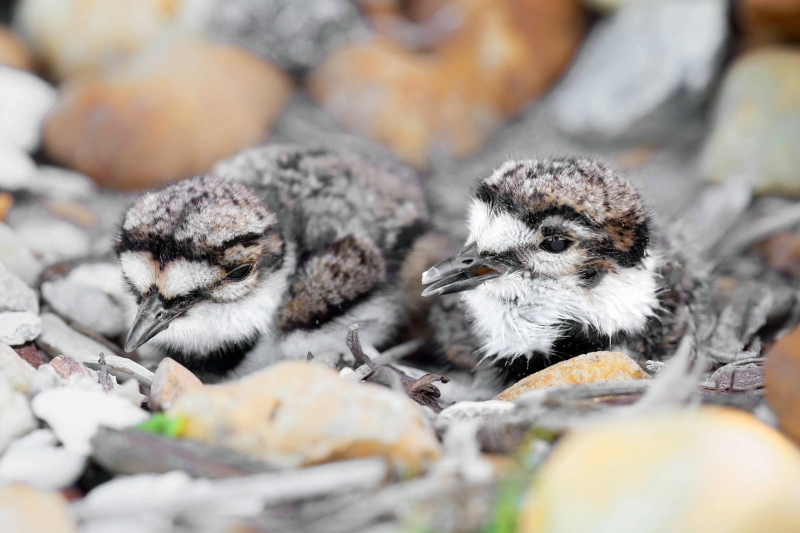
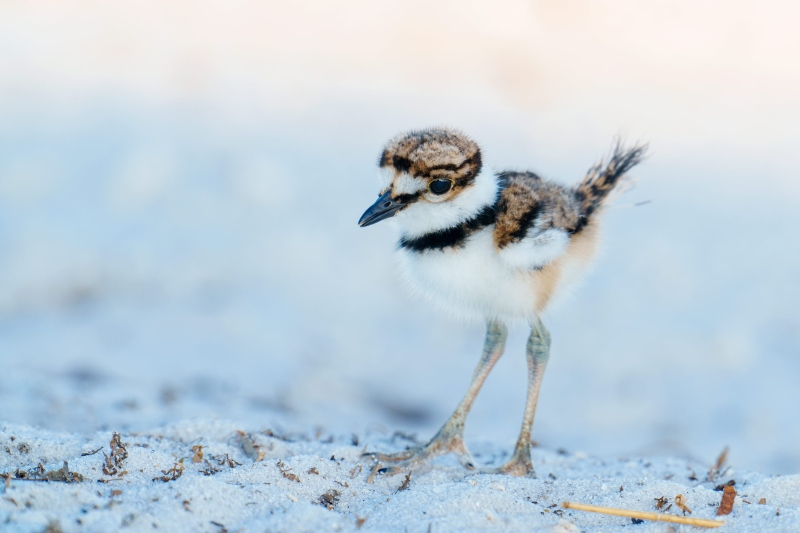
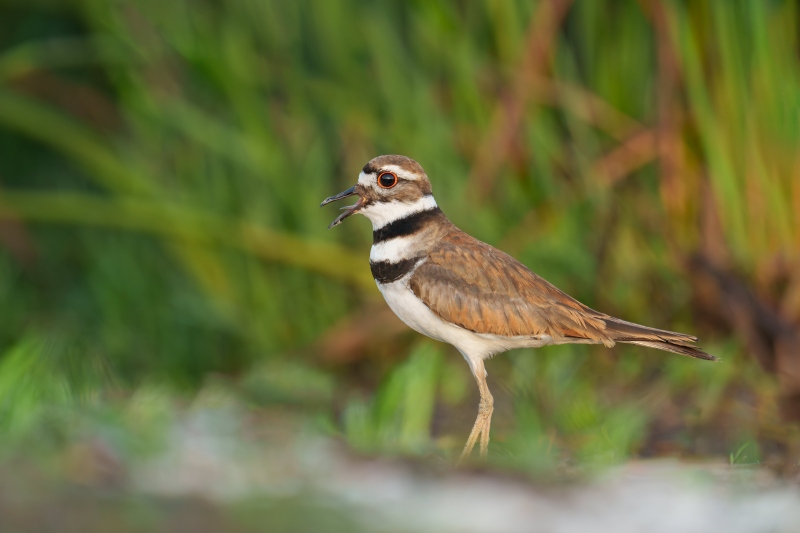
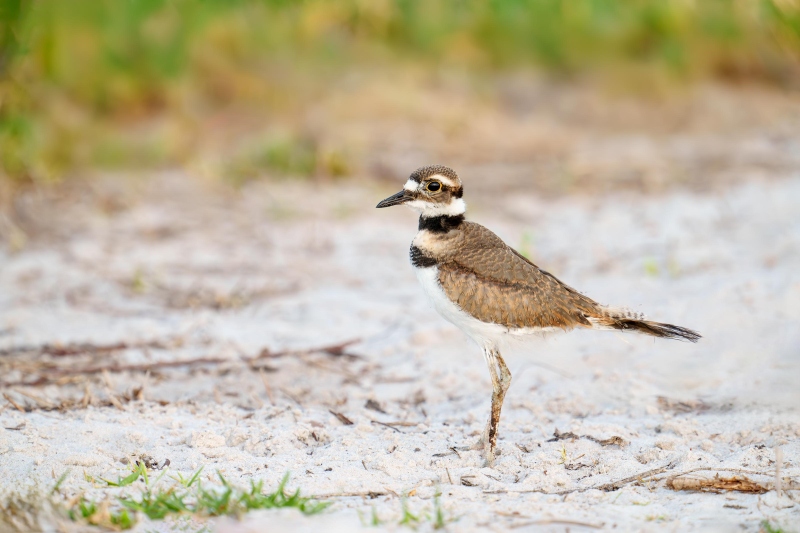
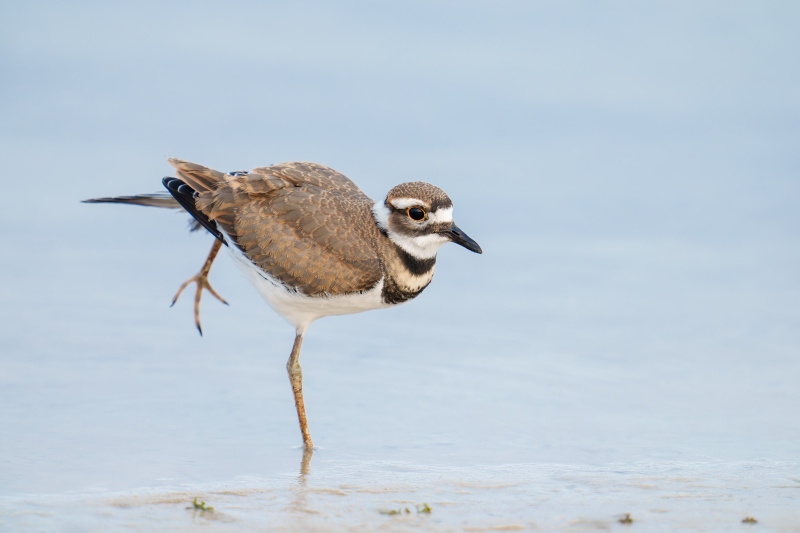













Likewise and even though I am a sucker for wing stretches, it ‘s hard to beat #2 for the reasons mentioned. I might have considered cloning out/removing the pine needle or whatever that little stick is in the right corner.
For me, the killer Killdeer is Image #2, partly for the wonderful background you mentioned, but also for catching the chick at it’s cutest stage, in a great pose, with big feet, little tail up in the air, exploring precociously, a mini Killdeer but quite distinct from an adult.
Thanks, Cliff. Can’t say that I disagree.
a